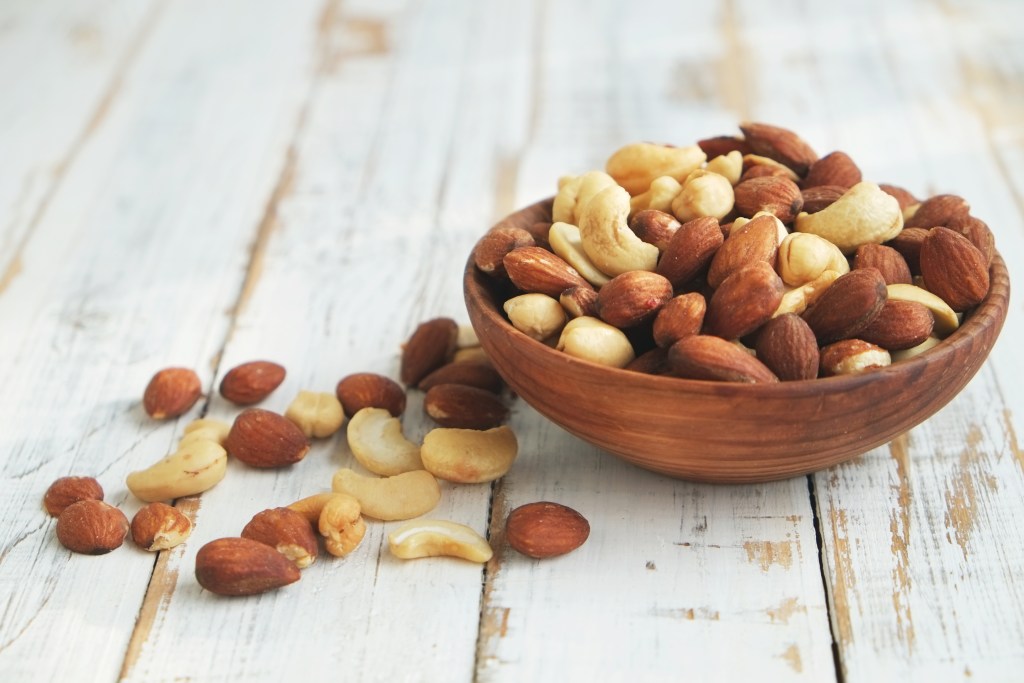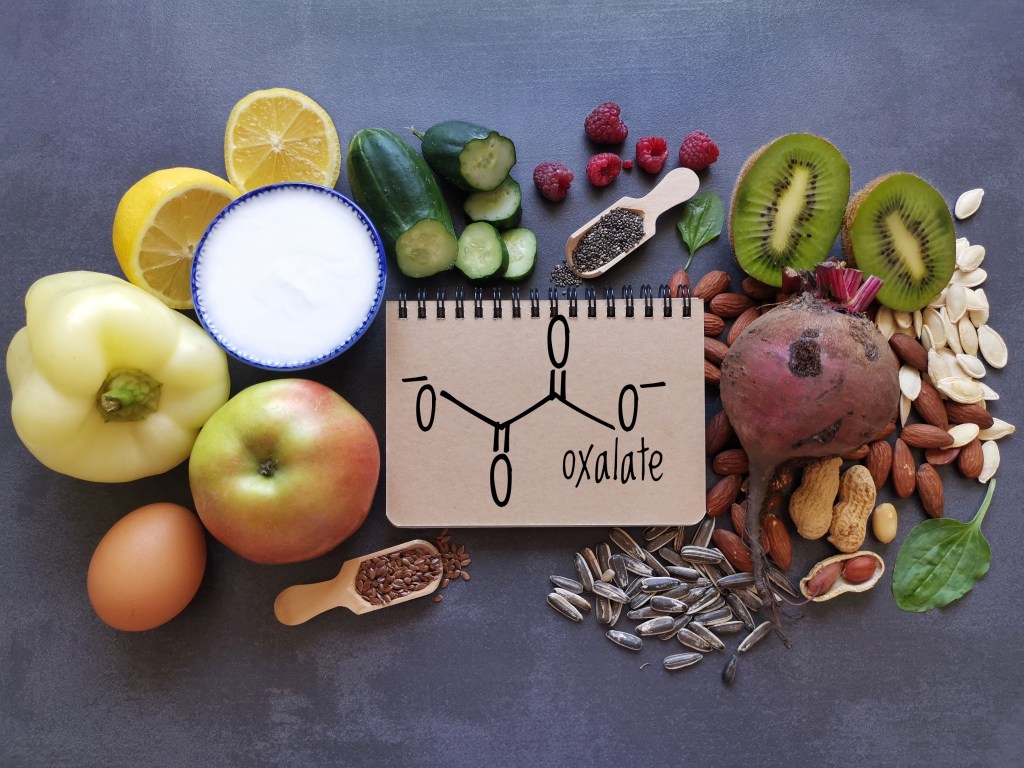While nuts are nutritious additions to any diet, some varieties are high in oxalates. Oxalates are a group of plant compounds that can trigger or worsen kidney problems.
Prioritizing low-oxalate nuts can be an excellent strategy for those focused on kidney health by providing healthy fats and essential minerals while limiting oxalate intake.
Discover the best nuts to choose on a low-oxalate diet and learn simple but effective tools to limit dietary oxalate exposure.
What are oxalates?
Oxalates, or oxalic acid, are organic compounds found in a wide range of plant-based foods, including spinach, rhubarb, almonds, cocoa, and nuts.
Once ingested, oxalates can bind to minerals, including calcium, forming salt complexes that are typically excreted via the urine.
When consumed in large amounts or not balanced with calcium-rich foods, oxalates may contribute to the formation of calcium oxalate stones, the most common type of kidney stone.
This leaves individuals with poor kidney function, or those at higher risk of kidney stone formation, particularly vulnerable to complications linked to a high-oxalate diet.
According to recommendations published by the University of Michigan Health System, individuals who benefit from restricting oxalates are generally advised to limit their daily intake to no more than 50 mg.1
This can be challenging, as oxalates are found in many foods and beverages. However, with careful planning and knowledge of which foods to avoid or limit, it’s possible to follow a low-oxalate diet without feeling deprived.
Fortunately, not everyone who consumes high-oxalate foods will experience problems, as genetic predisposition, hydration status, and mineral intake all influence how the body processes oxalates.
Watch the video below to learn which nuts contain the lowest amounts of oxalates.
Why choose low-oxalate nuts
Low-oxalate nuts offer a practical way to enjoy the benefits of these nutrient-rich ingredients while keeping oxalate intake within recommended levels.
Nuts offer essential minerals such as magnesium and potassium, along with antioxidants that can play a crucial role in supporting cellular function and metabolic health.
For individuals adjusting their diets to manage dietary oxalate levels, these nuts can be included more freely than higher-oxalate varieties.
When paired with calcium-rich foods, they may also help support optimal mineral utilization without having to eliminate all types of nuts.

Low-oxalate nuts
Nuts are rich sources of essential nutrients, including heart-healthy fatty acids, high-quality protein, dietary fiber, and various key minerals.
However, oxalate levels in nuts can vary widely, with certain types containing significantly higher concentrations than others.
Here are three types of nuts ideal for those concerned about oxalates.
1. Macadamia nuts
Macadamia nuts rank among the lowest in oxalate content, making them an ideal choice for those managing oxalate intake.
A study published in Nutrients reveals that raw macadamia nuts contain approximately 42 mg of oxalate per 3.5-ounce (100 g) serving.2
Macadamia nuts are also a rich source of monounsaturated fats, which support heart health and provide fiber, magnesium, and thiamin.
Moreover, macadamias are prized for their smooth, buttery texture and mild, slightly sweet taste.
This makes them a versatile ingredient, perfect for blending into creamy sauces and incorporating into low-carb crusts.
2. Pecans
Pecans are a flavorful, nutrient-rich tree nut that naturally falls into the low-oxalate category.
Research published in Urology states that the oxalate content in pecans can vary widely, ranging from approximately 4 to 404 mg per 3.5 ounces.3
However, when eaten in typical portions, such as a one-ounce serving, pecans generally contain well under 25 mg of oxalate, classifying them as a low-oxalate food.
In addition to their favorable oxalate profile, pecans are an excellent source of manganese, copper, and healthy fats that support energy metabolism, weight management, and cellular health.
Pecans also have a naturally sweet, buttery flavor that complements savory and sweet dishes, making them a mouthwatering addition to low-carb baked goods and salads.
3. Walnuts
Walnuts are another type of tree nut that can fit well into a low-oxalate eating plan when consumed in moderation.
According to data published by The Oxalosis and Hyperoxaluria Foundation (OHF), walnuts contain approximately 62 mg of oxalate per 3.5 ounces.4
A typical 1/4 cup serving contains around 19 mg of oxalate, placing it in the low-oxalate category based on standard serving sizes.
Nutritionally, walnuts are known for their high content of alpha-linolenic acid (ALA), a plant-based omega-3 fatty acid that plays a role in supporting cardiovascular and brain health.
Walnuts also provide magnesium, copper, and antioxidants, including polyphenols, which contribute to cellular protection and metabolic function.
With their slightly bitter, earthy flavor and soft texture, walnuts pair well with leafy greens and roasted vegetables, making them a delicious addition to a Healthy Keto® diet.

High-oxalate nuts
While pecans, walnuts, and macadamia are considered low-oxalate nuts, other varieties contain significantly higher oxalate levels and may not be suitable for those aiming to limit oxalates.
Here are the nuts to avoid and their average oxalate content per 3.5-ounce serving:
- Almonds: 369 mg
- Cashews: 249 mg
- Pine nuts: 185 mg
- Hazelnuts: 181 mg
These values categorize the nuts as high-oxalate, generally defined as containing 100 mg or more per serving.

How to reduce oxalates in nuts
While some nuts are naturally low in oxalates, others contain moderate to high levels that can significantly contribute to overall oxalate consumption.
Fortunately, several preparation methods and dietary strategies may help reduce oxalate content or minimize absorption.
Here are three steps you can take to reduce oxalates in nuts.
1. Boiling
Boiling is one of the most effective strategies for reducing oxalate levels in high-oxalate foods, as it allows soluble oxalates to leach into the cooking water.
Boiling nuts can reduce their soluble oxalate content, as some oxalates will leach into the water. It’s important to discard the boiling water to effectively lower oxalate intake.
2. Soaking
Soaking nuts in water for several hours may also reduce soluble oxalates by allowing them to leach into the soaking liquid.
This method is especially useful for raw nuts, as the soaking process can break down various anti-nutrients that bind to minerals, including oxalates.
After soaking, nuts should be thoroughly rinsed to remove any residual oxalates that may have been released into the water.
3. Pairing with calcium-rich foods
Combining higher-oxalate nuts like almonds, cashews, and peanuts with calcium-rich foods such as dairy products and leafy greens may help reduce oxalate absorption in the digestive tract.
“Calcium binds to oxalates in the gut, forming insoluble compounds that are less likely to be absorbed and are instead excreted from the body,” explains Dr. Berg. “This strategy helps maintain mineral balance and supports kidney health.”

More low-oxalate foods to enjoy
A variety of naturally low-oxalate foods provide essential minerals and contribute to a balanced, healthy diet.
These foods deliver numerous health benefits thanks to their rich nutrient content, including protein, healthy fats, and antioxidants.
Here are nutritious and health-promoting low-oxalate options to enjoy.
Eggs
High in protein and one of the best dietary sources of choline, eggs support brain and liver function while containing little to no oxalates.
Meat and poultry
Beef, chicken, and turkey are naturally oxalate-free and rich in essential nutrients, including B vitamins, iron, and zinc.
These nutrients play a vital role in supporting energy levels and strengthening the immune system.
Oily fish
Fatty fish such as salmon and sardines contain virtually no oxalates, but provide vitamin D and omega-3 fatty acids, which support heart function and promote bone health.

Cheese
Most cheeses are low in oxalates and provide calcium, which supports mineral balance, especially when consumed alongside oxalate-containing foods.
Avocados
Low in oxalates and high in potassium, magnesium, and healthy fats, avocados promote heart health and hydration without increasing the risk of kidney stones.
Mushrooms
Common varieties, such as white button and cremini mushrooms, contain low oxalate levels and provide selenium and antioxidants that support cellular function.
Seeds
Sunflower seeds and pumpkin seeds are naturally low in oxalates and packed with micronutrients, including vitamin E, magnesium, and zinc.
Regularly consuming these seeds can enhance the body’s antioxidant capacities and support nerve and muscle function.

Key takeaways
Choosing low-oxalate nuts, such as macadamia nuts, walnuts, and pecans, helps minimize the risk of kidney stones while providing essential minerals and fatty acids needed to promote a healthy body.
To reduce oxalate intake, consider boiling or soaking nuts and pairing high-oxalate foods with calcium-rich choices to limit absorption while maintaining a balanced, nutritious diet.
FAQ
1. What are the best low-oxalate nuts?
Macadamia nuts, walnuts, and pecans are among the best low-oxalate options. They offer protein, fiber, and a variety of vitamins and minerals while maintaining relatively low oxalate levels.
2. Are oxalates bad for you?
In moderate amounts, oxalates aren’t harmful to most individuals. However, those with a history of kidney stones or certain medical conditions may need to limit their intake.
It’s always best to consult with a healthcare professional before making significant dietary changes.
3. Do walnuts have less oxalate than almonds?
Yes, walnuts contain significantly fewer oxalates than almonds. Specifically, 3.5 ounces (100 g) of almonds contain around 369 mg of oxalates, while the same amount of raw walnuts contains just 62 mg.
4. How do you remove oxalates from nuts?
Boiling or soaking nuts in water can reduce their oxalate content by leaching out some of the oxalates, making them easier to digest and less likely to affect your body adversely.
5. How can you flush oxalates out of the body?
There are a few ways to flush oxalates out of the body. One option is to increase your fluid intake, as this can help dilute and remove excess oxalates through urine.
Another method is to include foods high in calcium in your diet, as calcium binds with oxalates and prevents absorption into the bloodstream.







